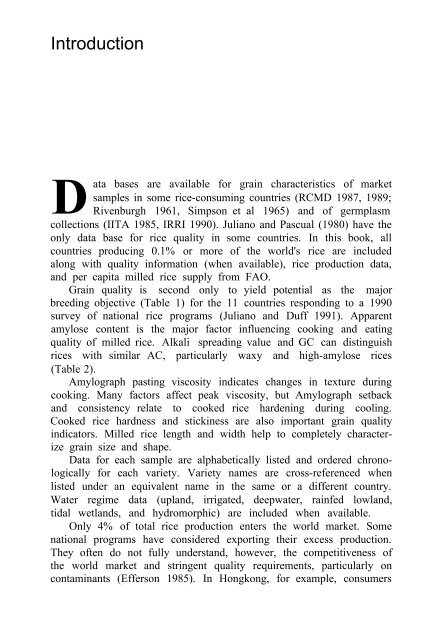Juliano et al. - 1993 - Grain Quality Evaluation of World Rices
Juliano et al. - 1993 - Grain Quality Evaluation of World Rices
Juliano et al. - 1993 - Grain Quality Evaluation of World Rices
Create successful ePaper yourself
Turn your PDF publications into a flip-book with our unique Google optimized e-Paper software.
Introduction<br />
D<br />
ata bases are available for grain characteristics <strong>of</strong> mark<strong>et</strong><br />
samples in some rice-consuming countries (RCMD 1987, 1989;<br />
Rivenburgh 1961, Simpson <strong>et</strong> <strong>al</strong> 1965) and <strong>of</strong> germplasm<br />
collections (IITA 1985, IRRI 1990). <strong>Juliano</strong> and Pascu<strong>al</strong> (1980) have the<br />
only data base for rice qu<strong>al</strong>ity in some countries. In this book, <strong>al</strong>l<br />
countries producing 0.1% or more <strong>of</strong> the world's rice are included<br />
<strong>al</strong>ong with qu<strong>al</strong>ity information (when available), rice production data,<br />
and per capita milled rice supply from FAO.<br />
<strong>Grain</strong> qu<strong>al</strong>ity is second only to yield potenti<strong>al</strong> as the major<br />
breeding objective (Table 1) for the 11 countries responding to a 1990<br />
survey <strong>of</strong> nation<strong>al</strong> rice programs (<strong>Juliano</strong> and Duff 1991). Apparent<br />
amylose content is the major factor influencing cooking and eating<br />
qu<strong>al</strong>ity <strong>of</strong> milled rice. Alk<strong>al</strong>i spreading v<strong>al</strong>ue and GC can distinguish<br />
rices with similar AC, particularly waxy and high-amylose rices<br />
(Table 2).<br />
Amylograph pasting viscosity indicates changes in texture during<br />
cooking. Many factors affect peak viscosity, but Amylograph s<strong>et</strong>back<br />
and consistency relate to cooked rice hardening during cooling.<br />
Cooked rice hardness and stickiness are <strong>al</strong>so important grain qu<strong>al</strong>ity<br />
indicators. Milled rice length and width help to compl<strong>et</strong>ely characterize<br />
grain size and shape.<br />
Data for each sample are <strong>al</strong>phab<strong>et</strong>ic<strong>al</strong>ly listed and ordered chronologic<strong>al</strong>ly<br />
for each vari<strong>et</strong>y. Vari<strong>et</strong>y names are cross-referenced when<br />
listed under an equiv<strong>al</strong>ent name in the same or a different country.<br />
Water regime data (upland, irrigated, deepwater, rainfed lowland,<br />
tid<strong>al</strong> w<strong>et</strong>lands, and hydromorphic) are included when available.<br />
Only 4% <strong>of</strong> tot<strong>al</strong> rice production enters the world mark<strong>et</strong>. Some<br />
nation<strong>al</strong> programs have considered exporting their excess production.<br />
They <strong>of</strong>ten do not fully understand, however, the comp<strong>et</strong>itiveness <strong>of</strong><br />
the world mark<strong>et</strong> and stringent qu<strong>al</strong>ity requirements, particularly on<br />
contaminants (Efferson 1985). In Hongkong, for example, consumers

















